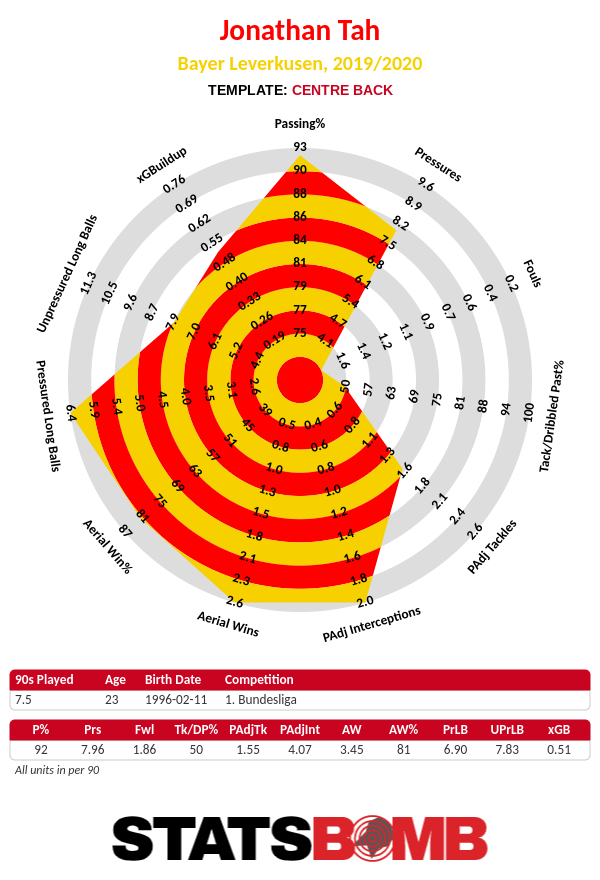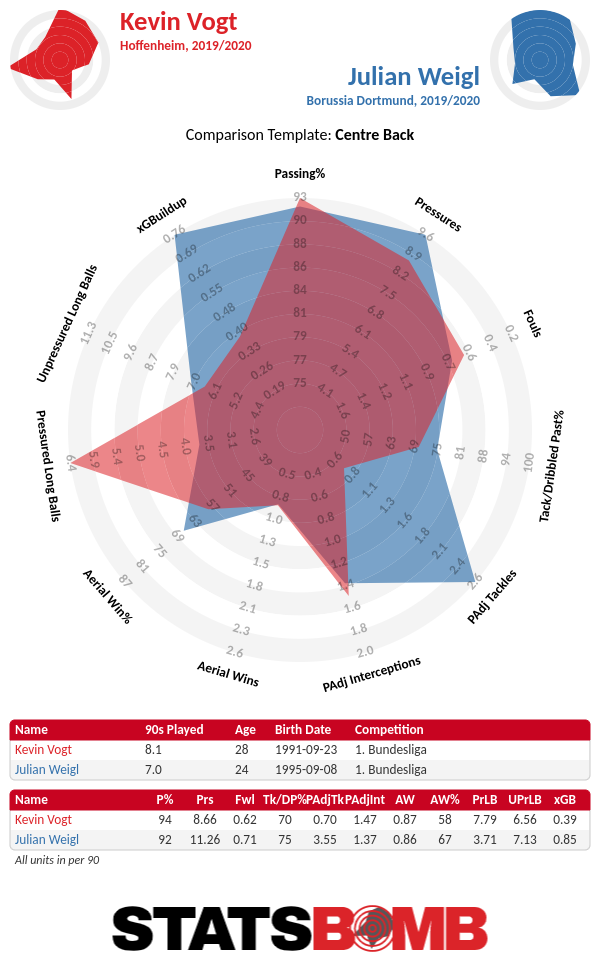Football is fast, football is fleeting. The current German footballing landscape is a prime example of that. Die Mannschaft won the World Cup in 2014 with a starting line-up that featured four centre backs. And now . . . now Joachim Löw’s national squad is running out of options at the heart of defence. The (forced) departure of the aging Jérôme Boateng and Mats Hummels from the German national team, this was supposed to herald the start of a new era. During a horrid World Cup in 2018, counterattacks by Mexico, Sweden, and South Korea embarrassed Germany’s back line more than a few times. This partly down to the fact that Boateng and Hummels had lost a step, speed-wise, but the risky, possession-oriented team structure was as much the culprit for creating vulnerability in transition. The result was an attack that couldn’t outscore the mistakes of their shoddy defence enough to even make it out of the group phase. So Löw decided to thoroughly shake things up. Former mainstays like Hummels, Boateng, Thomas Müller and Sami Khedira were no longer needed. Löw also shifted to a modern 3-4-2-1 as their primary formation. But waving goodbye to the former best centre back pairing in the world, whilst simultaneously shifting to a formation that requires not two, but three central defenders, has been tough for Die Mannschaft. Especially now that the only centre back who wasn’t surrounded by any form of doubt, Bayern München’s Niklas Süle, has been ruled out for the upcoming European Championship with a worrisome knee injury. Add to that that their second-most trustworthy central defender, Chelsea’s Antonio Rüdiger, has played 45 competitive minutes this season after he picked up a pelvis injury shortly after recovering from knee surgery. So yeah, not great. To complete this holy mess, Emre Can, the Juventus midfielder who Löw frequently plays in the back three, got sent off in the last qualification match against Estonia (an 0-3 victory) after just 14 minutes of play, so he’ll miss some valuable in-game practice time in the upcoming match against Belarus. It also doesn't help that Can rarely starts under Juventus manager Maurizio Sarri. Where does Germany go from here? Keep in mind that (A) Löw still isn’t in the business of calling players back who he deemed no longer necessary in the past — which rules out not only the return of Hummels, but also makes bring back the Bender Brothers of Bayer Leverkusen an unlikely scenario — and (B) the national team manager is likely to stick with the current 3-4-2-1 formation, because of the positive effects it has on the production of attacking stars Serge Gnabry, Marco Reus and (the truly on-fire) Timo Werner. At the very minimum, they’ll need five players who can play as a centre back on their roster. Pencilling in Rüdiger seems a bit optimistic, judging by the somewhat worrisome reports coming from Chelsea in regards to his recovery. Besides converted centre back Can, Löw has called up four central defenders for the upcoming two qualifiers. Let’s take a look at those four first, then discuss the other candidates hiding in plain sight in the Bundesliga.
Current call-ups
Matthias Ginter (Borussia Mönchengladbach) Borussia Mönchengladbach sit atop the league table after ten matchdays, and are fully back in the mix in their Europa League group after edging out AS Roma in stoppage time on Thursday (2-1). Ginter is likely the first defender that manager Marko Rose writes down on his team sheet, and his individual numbers of the current season look good.  What’s not to love, right? Well, whilst their attacking output and hardcore pressing seem to be fully legit, Gladbach has profited from some sloppy finishing by opposing teams thus far.
What’s not to love, right? Well, whilst their attacking output and hardcore pressing seem to be fully legit, Gladbach has profited from some sloppy finishing by opposing teams thus far.  Ginter is probably the best ball-playing centre back Löw currently has at his disposal, but he can be coaxed into unnecessary long balls, something the national team manager is not a fan of. His average mobility means that Löw has to bring in more athletic types at the other two central defending positions when he starts Ginter. Jonathan Tah (Bayer Leverkusen) Tah was nationally ridiculed after a couple of bumbling errors in Germany’s recent home loss (2-4) to the Netherlands. As a true Tah stan, all I have to say is this: As the only non-converted-from-another-position and athletically superior defender in the backline at Bayer Leverkusen, Tah has to do a lot of cleaning up given manager Peter Bosz’ super aggressive pressing style. I mean, look at this:
Ginter is probably the best ball-playing centre back Löw currently has at his disposal, but he can be coaxed into unnecessary long balls, something the national team manager is not a fan of. His average mobility means that Löw has to bring in more athletic types at the other two central defending positions when he starts Ginter. Jonathan Tah (Bayer Leverkusen) Tah was nationally ridiculed after a couple of bumbling errors in Germany’s recent home loss (2-4) to the Netherlands. As a true Tah stan, all I have to say is this: As the only non-converted-from-another-position and athletically superior defender in the backline at Bayer Leverkusen, Tah has to do a lot of cleaning up given manager Peter Bosz’ super aggressive pressing style. I mean, look at this:  That is not a centre back-friendly playing style, as it leaves a lot of space to cover behind the back line and produces many situations where a central defender has to step in to fill the gap of a midfielder who is further upfield committed to a wave of pressing. If we take a gander at Tah’s individual numbers, we get a very different perspective than the one we got from his unfortunate outing against the Dutch. Tah, despite those high profile gaffes, does a lot of work.
That is not a centre back-friendly playing style, as it leaves a lot of space to cover behind the back line and produces many situations where a central defender has to step in to fill the gap of a midfielder who is further upfield committed to a wave of pressing. If we take a gander at Tah’s individual numbers, we get a very different perspective than the one we got from his unfortunate outing against the Dutch. Tah, despite those high profile gaffes, does a lot of work.  Niklas Stark (Hertha BSC) At 6 foot 4 and almost 200 lbs, Stark is a big guy. Almost as big as his Mannschaft teammate Tah. But the Berlin defender is much more of the ball-playing central defender, surprisingly quick and agile for someone of his build. Stark has proved himself an apt contributor to Hertha’s build-up play.
Niklas Stark (Hertha BSC) At 6 foot 4 and almost 200 lbs, Stark is a big guy. Almost as big as his Mannschaft teammate Tah. But the Berlin defender is much more of the ball-playing central defender, surprisingly quick and agile for someone of his build. Stark has proved himself an apt contributor to Hertha’s build-up play.  However, his style raises questions about whether Stark’s skillset is complementary to those of the other German centre backs. Stark has fine foot-speed, but would not be your ideal choice as an athletic, space-eating counterweight to the slower Ginter. Additionally, despite his size, he's not particularly imposing in the air. Robin Koch (SC Freiburg) We covered Koch, his team Freiburg and his surprisingly well-playing central defending partner Dominique Heintz extensively in last week’s Bundesliga column. Koch’s size, speed, ball-playing skills and weaknesses are similar to that of Stark. But the 23-year-old Freiburg defender does seem to have leapfrogged his 24-year-old national teammate from Berlin in Löw’s backline hierarchy.
However, his style raises questions about whether Stark’s skillset is complementary to those of the other German centre backs. Stark has fine foot-speed, but would not be your ideal choice as an athletic, space-eating counterweight to the slower Ginter. Additionally, despite his size, he's not particularly imposing in the air. Robin Koch (SC Freiburg) We covered Koch, his team Freiburg and his surprisingly well-playing central defending partner Dominique Heintz extensively in last week’s Bundesliga column. Koch’s size, speed, ball-playing skills and weaknesses are similar to that of Stark. But the 23-year-old Freiburg defender does seem to have leapfrogged his 24-year-old national teammate from Berlin in Löw’s backline hierarchy.
The long shots
‘Style breakers’: Kevin Vogt (Hoffenheim) and Julian Weigl (Borussia Dortmund) There’s some logic behind Löw not calling up the best two available Bundesliga centre backs that remain. Both Vogt and Weigl are former central midfielders who’ve been converted to centre back: Vogt as the passing metronome in the middle of Julian Nagelsmann’s (and now Alfred Schreuder’s) back three at Hoffenheim, Weigl as a-better-alternative-than-the-ones-we-have by Lucien Favre at Dortmund.  As you can see from the radars above, these two are very good at passing the ball. But a big part of the big rebrand that Löw and his officials at the German football federation wanted to establish after the World Cup debacle is a more dynamic playing style that's less dependent on possessional play. Even though Hoffenheim employs some forms of direct football, and the flashy transition skills of Reus and Sancho are one of the few things keeping Dortmund semi-afloat right now, both Vogt and Weigl would fit better in a patient attacking style.
As you can see from the radars above, these two are very good at passing the ball. But a big part of the big rebrand that Löw and his officials at the German football federation wanted to establish after the World Cup debacle is a more dynamic playing style that's less dependent on possessional play. Even though Hoffenheim employs some forms of direct football, and the flashy transition skills of Reus and Sancho are one of the few things keeping Dortmund semi-afloat right now, both Vogt and Weigl would fit better in a patient attacking style.
The weird, out-of-the-box option: Benjamin Hübner (Hoffenheim)
Which brings us to the one candidate you truly didn’t expect to find in this article. Hübner is already 30 years old, and it took until he was 26 years old for him to make his first minutes at the top level of German club football, at promoted FC Ingolstadt in 2015. While the solid Hoffenheim defender might not have the same level of technical skill or individual talent that most German internationals have, he does bring two valuable qualities to the table. First, he is a defence-first type of centre back, but not the type that frantically hooves the ball upfield blindly at the first sign of pressure.  Second, Hübner is — wait for it — left-footed! Rüdiger, Can, Tah, Ginter, Stark and Koch — even Vogt and Weigl, for that matter — are all righties. Which, okay, that's fine. But it's not ideal when playing three at the back. The left-sided central defender, when right-footed, will always find himself in a bit of a jam when the spaces tighten up during build-up play. That alone should see Hübner considered for the national team. If Löw is going to call up five, or even six, centre backs for his 2020 Euros roster, there should be room for at least one leftie.
Second, Hübner is — wait for it — left-footed! Rüdiger, Can, Tah, Ginter, Stark and Koch — even Vogt and Weigl, for that matter — are all righties. Which, okay, that's fine. But it's not ideal when playing three at the back. The left-sided central defender, when right-footed, will always find himself in a bit of a jam when the spaces tighten up during build-up play. That alone should see Hübner considered for the national team. If Löw is going to call up five, or even six, centre backs for his 2020 Euros roster, there should be room for at least one leftie.